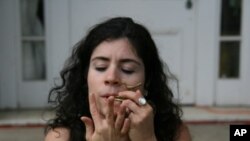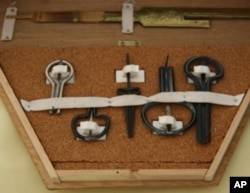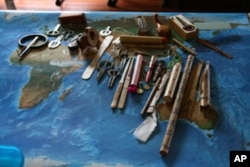The Jew’s harp, a plucked-mouth instrument found all over the world, has absolutely nothing to do with Jews.
But it does have a distinctive sound and a lot of fans. Many of them have gathered at the North American Jew’s Harp Festival in the western state of Oregon to celebrate the tiny instrument.
If you haven’t heard of the Jew’s harp, you’re not alone. Even its biggest fans were once in the dark.
“I thought it was a bike tool or a screwdriver or something," says ethnomusicologist Deirdre Morgan, executive director of the Jew's Harp Guild. "I found out it was a musical instrument. And I thought, 'Oh it’s that thing that I’ve heard in the background of old-time music.' I didn’t know what it was called, so I Googled the words ‘twangy mouth instrument.’”
Morgan is writing her masters' thesis on the Asian Jew’s harp, one of the instrument's many variations. Now an expert, she explains how they work.
“It’s a fairly simple principle. It's a tongue, or a lamella, that you flick, and it goes doy-oy-oy-oy-oy. And then it’s just one more step to take the twig up to your mouth, and it gets all these different pitches.”
The Jew’s harp always has that fundamental note of the lamella that gives it a droning sound, like a bagpipe. But it’s what you do with your mouth that changes things.
"If you open up your esophagus you get the lower notes," player Dan Gossi explains,"and if you make your mouth a real tight, small cavity, you get the higher notes. But basically you’re the instrument."
Because the Jew’s harp is so simple, different versions have cropped up across the globe. According to Morgan, its small size helped fuel its popularity, going as far back as the 15th century and maybe even earlier.
“It’s easy to fit in a pocket. And it was definitely traded a lot along the Silk Road from Northern China, Russia, Mongolia, Siberia, down through India and all the ‘stans,' Afghanistan, into Europe," Morgan says. "And then the European harps were the ones that were brought into Northern America.”
You can find nearly all of these versions at the festival. There’s the Filipino kubing, made of bamboo. The Chinese ho-ho has a different brass plate for each key. With the Balinese genggong, you pluck the lamella by tugging on a string.
Despite the different shapes, sizes and materials, all belong to the same twangy family. But even harpers say it can be a hard family to love. Rob Hoffman has been coming to the festival for five years.
“I don’t like hearing hours and hours of Jew’s harp as a solo," says Rob Hoffman, who has attended the festival for five years. "It gets kind of old. But what it does is, when played with other instruments, it’s like the gravy on the potatoes. It adds inflection, it adds something unexpected, it adds a counterpoint.”
But during a few loud days in August, the twangy global instrument emerges from its supporting role for a chance to take the spotlight.











